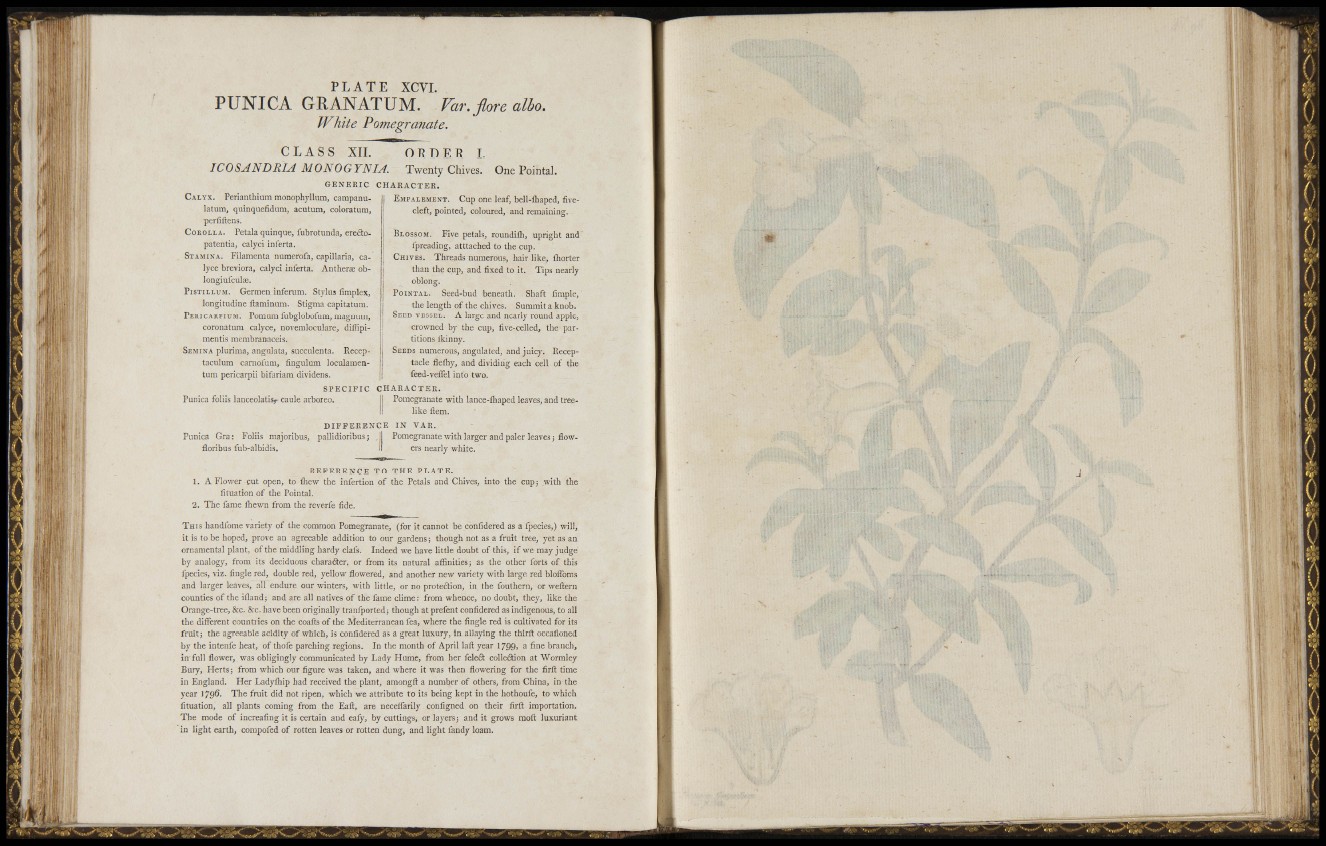
fil! líiií 1
' T i n - ; : -i
li
-ILI'''I "U
- I f ' ' ' i
•: • ií. , li; •
' 'l'if,
P L A T E XCVI.
PUNICA GRANATUM, Far. flore albo.
White Pomegranate.
C L A S S XIL ORDER L
ICOSANDRIA MONOGYNIA. Twenty Chives.
G E N E R I C CHARACTER.
Periaiitliium monophyllnra, campanu-
One Pointai.
C A L Y X .
latum, quinquefidum, acutum, coloratura,
perfiftens.
C O R O L L A . Pétala quinqué, fubrotunda, ereiStopatentia,
calycl inferta.
STAMINA. Filamenta numerofa, caplllaria, calyce
breviora, calyci inferta. Antherae oblongiulculae.
PisTiLLUM. Germen inferum. Stylns íimplex,
longitudine íiaminum. Stigma capitatum.
P E K I C A R P I Ü M . Pomum fubglobofum, magnum,
coronatum calyce, novemloculare, diflipimentis
membranaceis.
S E M I N A plurima, angulata, succulenta. Receptaculum
carnofum, fingulum loculamentum
pericarpii bifariam dividen®.
S P E C I F I C
Punica foliis lanceolatisj. caule arboreo.
EMPALEMENT. Cup one leaf, bell-fliaped, fivecleft,
pointed, coloured, and remaining.
BLOSSOM. Five petals, roundifli, upright and
fpreading, atttached to the cup.
CHIVES. Threads numerous, hair like, fliorter
than the cup, and fixed to it. Tips nearly
oblong.
P o i N T A L . Seed-bud beneath. Shaft fimple,
the length of the chives. Summit a knob.
SEED VESSEL. A large and nearly round apple,
crowned by the cup, five-celled, the partitions
ikinny.
SEEDS numerous, angulated, and juicy. Receptacle
fleihy, and dividing each cell of the
feed-veflel into two.
C H A R A C T E R .
Pomegranate with lance-fliaped leaves, and treelike
ftem.
D I F F E R E N C E IN VAR.
Punica Gra: Foliis majoribus, pallidioribus ;
floribus fub-albidis.
Pomegranate with larger and paler leaves; flowers
nearly white.
R E F E R E N C E TO THE PLATE.
1. A Flower cut open, to fliew the infertion of the Petals and Chives, into the cup; with the
fituation of the Pointai.
2. The fame fliewn from the reverfe fide.
T H I S handibme variety of the common Pomegranate, (for it cannot be confidered as a fpecies,) will,
it is to be hoped, prove an agreeable addition to our gardens; though not as a fruit tree, yet as an
ornamental plant, of the middling hardy clafs. Indeed we have little doubt of this, if we may judge
by analogy, from its deciduous charafter, or from its natural affinities; as the other forts of this
fpecies, viz. fingle red, double red, yellow flowered, and another new variety with large red blofl^oms
and larger leaves, all endure our winters, with little, or no proteftion, in the fouthern, or wefteru
counties of the ifland; and are all natives of the fame clime: from whence, no doubt, they, like the
Orange-tree, &c. &c. have been originally tranfported; though at prefent confidered as indigenous, to all
the different countries on tiie coafts of the Mediterranean fea, where the fingle red is cultivated for its
fruit; the agreeable acidity of which, is confidered as a great luxury, in allaying the thirft oecafioned
by the intenfe heat, of thofe parcliing regions. In the month of April laft year 1799, ^ ^ns branch,
in full flower, was obligingly communicated by Lady Hume, from her feleii: colleftion at Worraley
Bury, Herts; from which our figure was taken, and where it was then flowering for the firfl: time
in England. Her Ladyfliip had received the plant, amongft a number of others, from China, in the
year J 796. The fruit did not ¡ipen, which we attribute to its being kept in the hothoufe, to which
fituation, all plants coming from the Eafl:, are necelfarily configned on their firft importation.
The mode of increafing it is certain and eafy, by cuttings, or layers; and it grows moft luxuriant
'in light earth, compofed of rotten leaves or rotten dung, and light fandy loam.
1